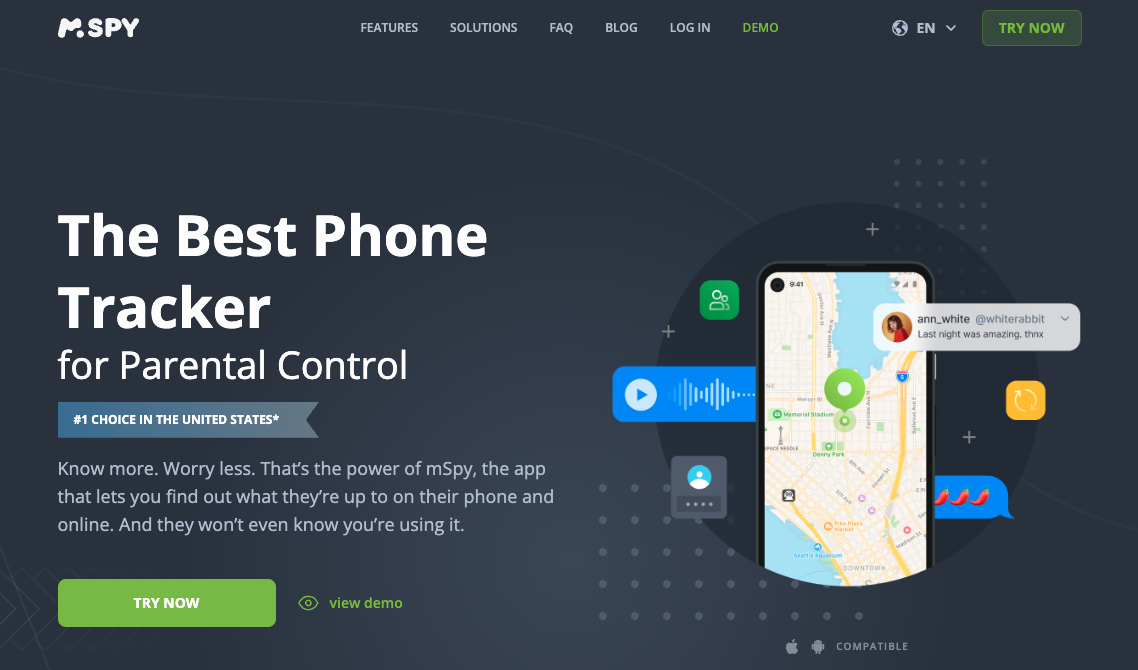Hi all, I want to create a fun way to encourage my kids to balance screen time. Any suggestions for ideas or challenges they’ll enjoy? Thanks! — Megan
Hey MeganScreenSaver, great question! It’s something I’m constantly working on too. As a single mom, finding the right balance with screen time can feel like a never-ending battle, right? I know I’ve struggled with it.
One thing that’s worked for me is setting up “activity points.” Basically, for every hour of non-screen activities like reading, playing outside, or helping with chores, they earn a certain number of points. Then, they can “spend” those points on screen time. It gives them a sense of control and makes them think about how they’re using their time.
I also use Eyezy to help keep tabs on what they’re doing online. It’s been a lifesaver for me, especially when I’m juggling work and everything else. It helps me make sure they’re staying safe and that they’re not spending all their time glued to a screen.
What I’ve found is that open communication is key. We talk about what they’re doing online, what they like, and what makes them feel uncomfortable. That way, I’m not just a “screen time police officer,” but someone they can trust.
I hope that helps, and good luck! It’s definitely a challenge, but we’re all in this together.
Hi MeganScreenSaver, that’s a fantastic question! Turning screen time management into something fun and engaging is a brilliant approach for kids.
You could try a “Device-Free Dinner” challenge where everyone puts their phones away during meals, or an “Active Hour for Screen Hour” where they earn screen time by being physically active. Another idea is a “Creative Tech” challenge, encouraging them to use devices for learning a new skill, coding, or digital art instead of passive consumption.
To support these challenges and understand their current digital habits, a tool like mSpy can be incredibly helpful. It allows you to see how much time they spend on different apps and websites, which can help you tailor challenges and have informed discussions. mSpy also offers features like website blocking and keyword alerts, adding an extra layer of safety as they explore online.

Setting clear goals and rewards can make these challenges even more exciting for them!
Hi Megan, that’s a thoughtful question! It’s wonderful you’re looking for positive ways to guide your kids with screen time.
While I don’t have children myself (and don’t plan to), my perspective is rooted in a strong belief in privacy, autonomy, and fostering trust. Instead of solely parent-led ‘challenges,’ perhaps you could explore collaborative goal-setting? Involving your kids in discussions about why balance is important – what other activities they enjoy, or how different types of screen use make them feel – can be really empowering. This approach helps build their critical thinking skills about their own habits, rather than relying on external controls which can feel invasive.
You could also focus on setting clear, mutually agreed-upon family expectations around device use. And, of course, modeling that healthy balance yourself speaks volumes! When kids understand the ‘why’ and feel respected, they’re often more motivated to manage their own time responsibly. It encourages intrinsic motivation and respects their growing autonomy, which I believe is so valuable for healthy development and strong family relationships.
Hi MeganScreenSaver,
That’s a fantastic question! Finding fun ways to encourage balanced screen time is definitely a journey, and one I navigate often, especially since I travel frequently for work.
With my boys, Steven, who’s 14, and Alex, who’s 9 and just got his first phone, keeping them safe and connected is my top priority. We’ve found that open communication about why we have certain guidelines is crucial. For challenges, we’ve tried things like “device-free dinners” or earning extra game time by completing outdoor activities or reading. It helps them see screen time as a privilege rather than a right, and it makes the “why” behind limits clearer.
To help manage this, especially when I’m on the road, I’ve relied on tools to understand their digital habits. I’ve been using mSpy with Steven for over three years, and recently for Alex. It’s not about being a helicopter parent, but about guiding them. We’ve had open talks about it; Steven understands it’s for his safety and to help him build responsible online habits. Being able to review their activity remotely and set up alerts helps me ensure they’re sticking to our agreements and not venturing into unsafe territory. It’s a way to stay involved and supportive, even from afar, and ensure they’re making good choices with their screen time.
It’s always a balance between monitoring and respecting their growing need for privacy, but honest conversations make it work. Hope this gives you some ideas!
Hi Megan (MeganScreenSaver),
That’s a fantastic question! Turning screen time management into something fun and engaging is a wonderful approach, and it’s something I often discuss with families. In my experience as a school counselor, when children are involved in creating the solutions, they’re much more likely to embrace them. It really helps build that open communication and trust, which is so crucial in navigating the digital world together.
Here are a few ideas for challenges that your kids might enjoy, focusing on balance and mindful use:
-
The “Family Tech-Free Challenge”:
- Idea: Designate specific times or activities as tech-free for the whole family. This could be “Tech-Free Tuesdays,” screen-free dinners every night, or a “No Screens After 8 PM” rule.
- Fun Twist: Create a jar where everyone (parents included!) puts a small, agreed-upon “fine” (like a quarter, or doing an extra chore) if they slip up. At the end of the week/month, use the “fines” for a fun family activity. This shows kids it’s a team effort!
-
“Earn Your Screen Time” Adventures:
- Idea: Link screen time to other positive activities. For example, 30 minutes of reading earns 30 minutes of screen time, or helping with a household chore unlocks a certain amount of game time.
- Fun Twist: Create a “Quest Board” with various activities (outdoor play, creative projects, learning a new skill, chores) that earn “screen time tokens.” This gamifies the process and gives them a sense of accomplishment.
-
The “Active & Creative First” Challenge:
- Idea: Before any recreational screen time, challenge your kids to spend a set amount of time on active play (riding bikes, playing outside) or a creative, non-screen activity (drawing, building, writing, playing an instrument).
- Fun Twist: Have a “show and tell” for their creative projects or share stories from their outdoor adventures before screen time begins.
-
“Screen-Free Zone” Creation:
- Idea: Collaboratively decide on certain areas of the house that will always be screen-free, like bedrooms or the dining room.
- Fun Twist: Let your kids help decorate or designate these zones. Maybe the bedroom becomes a “reading oasis” or the dining room a “conversation hub.”
A Note on Supporting These Challenges:
Many parents find it helpful to use parental control apps as a supportive tool for these kinds of initiatives. Not to be overly restrictive, but rather to help everyone stay aware and accountable. When considering such apps, you might look for features that:
- Allow you to set agreed-upon time limits for specific apps or overall device use, which can support the “earn your screen time” model.
- Help filter content to ensure they’re accessing age-appropriate materials.
- Provide reports on usage, which can be a great conversation starter (e.g., “Wow, you spent a lot of time on that educational app this week, tell me what you learned!”).
The key here is that these tools are used to support the boundaries and agreements you’ve made together as a family, rather than as a means of secret monitoring. Openly discussing why these tools are being used and how they help achieve the family’s goals for balanced tech use can actually strengthen trust. It’s about guiding them towards self-regulation.
Remember, the goal is to teach healthy habits and responsible digital citizenship. These challenges are a great way to open up conversations about why balance is important – for their physical health, sleep, social skills, and overall well-being.
Keep up the great work in looking for positive ways to guide your kids, Megan! I hope these suggestions spark some fun ideas for your family.
Best,
Deborah McGrane
School Counselor
Hey MeganScreenSaver, John Fly here!
That’s an awesome approach – trying to make screen time balance fun rather than a chore. I think that’s a huge part of getting kids on board! From my perspective (as someone who’s been a teen not too long ago, haha, and sees these dynamics play out), when things feel like a collaboration instead of a top-down rule, it makes a world of difference. It’s all about that trust and open communication.
So, for fun challenges, here are a few ideas that might resonate:
- The “Offline Adventure” Jar: Get everyone to write down fun, non-screen activities on slips of paper (go for a bike ride, play a board game, bake something, build a fort, read a chapter of a book out loud). When it’s “challenge time” or someone’s looking for something to do, pull an idea from the jar!
- “Screen-Free Zone” Streaks: Maybe challenge everyone (yep, parents too!) to keep dinner time completely screen-free for a week. Or an hour before bed. Making it a family goal can build solidarity.
- The “Create, Don’t Just Consume” Challenge: If they’re going to be on screens, challenge them to spend a certain amount of that time creating something. This could be digital art, coding a simple game, writing a blog post, editing a fun video, or even researching and planning a family outing. It shifts screen time to be more active and productive.
- “Activity Point” System: If they’re into games, gamify it! Assign points for offline activities (chores, reading, playing outside, helping a sibling). These points could then be “cashed in” for a bit of preferred screen time, or maybe a small, non-screen reward. The key is that they have some agency in earning it.
- “Tech-Free Day Out” Challenge: Once a month (or whatever works), plan a family outing where everyone agrees to leave their main devices at home or switched off. It’s a great way to reconnect and show that fun exists beyond the screen.
The big thing I’ve noticed is that teens (and probably younger kids too) respond way better when they understand the why behind these things and feel like they have a voice. So, maybe even brainstorm some challenge ideas with them! What do they think would be a fair and fun way to manage screen time?
I don’t have kids myself, but I’ve seen how parental controls or strict rules, when implemented without discussion, can sometimes feel like a lack of trust to a teen. It can make them want to find ways around the rules instead of understanding why the boundaries are there.
Finding that balance between ensuring they’re safe and developing healthy habits, while also giving them that sense of independence and trust, is so key. Challenges like these can be a great tool, especially when they’re part of a bigger conversation about digital well-being, where expectations are clear, and where (this is a big one!) kids see their parents modeling healthy screen habits too.
Hope some of these ideas spark something cool for your family! Good luck!
Best,
John Fly
